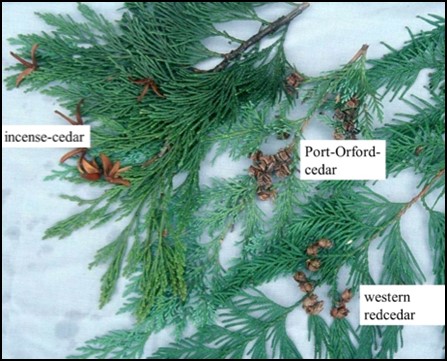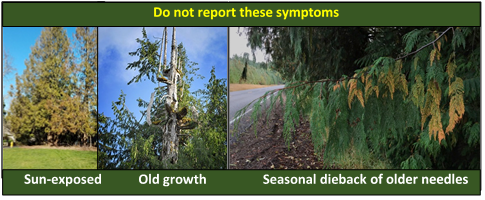Christin Buhl, Oregon Department of Forestry Entomologist
From Oregon through western Canada, western redcedar (Thuja plicata, WRC) has been dying in areas where it should be thriving, such as along streams and within closed canopies. The cause for this sometimes sudden and expanding dieback is currently unknown. Insects and diseases of WRC are typically secondary, meaning that they are not direct tree killers but are opportunistic pests and can only attack dead and dying trees. Redcedar can even tolerate endemic levels of bark beetles and stem decay for many years. These known pests have not always been found in dieback pockets nor have novel pests been observed.
The predominant theory for sudden mortality is that trees may be impacted by a changing climate, including increasing average temperatures and drought stress in the form of reduced and inconsistent precipitation. Even shaded sites along streams are at risk due to higher than usual average temperatures and reduced stream flow. Western redcedar is a species more sensitive to slight changes in abiotic conditions and may be crossing the lower limits of where they can thrive in some areas.
Looking for the cause
A team including Oregon Department of Forestry (ODF), Washington Department of Natural Resources (WADNR), the U.S. Forest Service (USFS), various university researchers and natural resource agencies are collaborating to collect locations to determine the distribution and possible cause(s) of dieback. We are mapping locations of dieback and monitoring some of these sites over the long-term.
We are now asking for your help in identifying sites of where dieback and tree decline is occurring. We are looking for pockets of dieback containing at least two mature trees with any of the following symptoms:
Do not report sites where the cause of dieback is known (e.g., mechanical damage, single sun-exposed trees, decadent old growth candelabra crowns or symptomatic trees in known root disease pockets) or trees with normal, seasonal dieback of older needles rather than whole-branch mortality.
Lastly, western redcedar may be confused with the other two species that we call “cedar”: incense cedar and Port Orford cedar (none are true cedar, which do not occur naturally in the PNW).The easiest way to identify western redcedar is by looking at the cones.

Western redcedar produces cones that look like woody roses, incense cedar has larger cones that split open like duck bills, and Port Orford cedar has cones that resemble soccer balls. Assist us in this effort to understand what is happening with this majestic staple of Pacific Northwest forests and urban areas.
Are you seeing these symptoms on western redcedar in your area? We need your help locating and reporting dying and symptomatic WRC across the species distribution!
Please submit GPS locations of western redcedar dieback: Christine Buhl, ODF Entomologist in Oregon (christine.j.buhl@oregon.gov)



